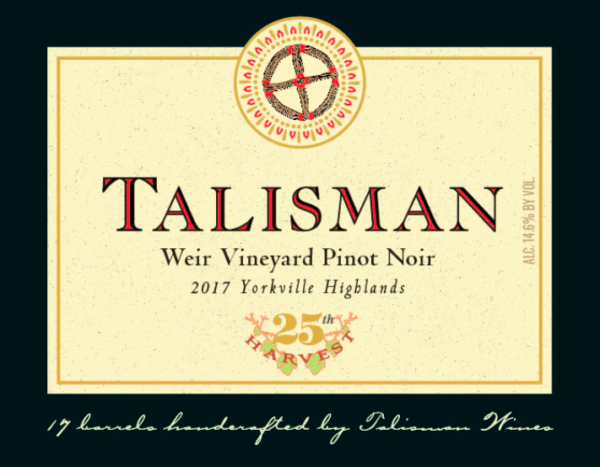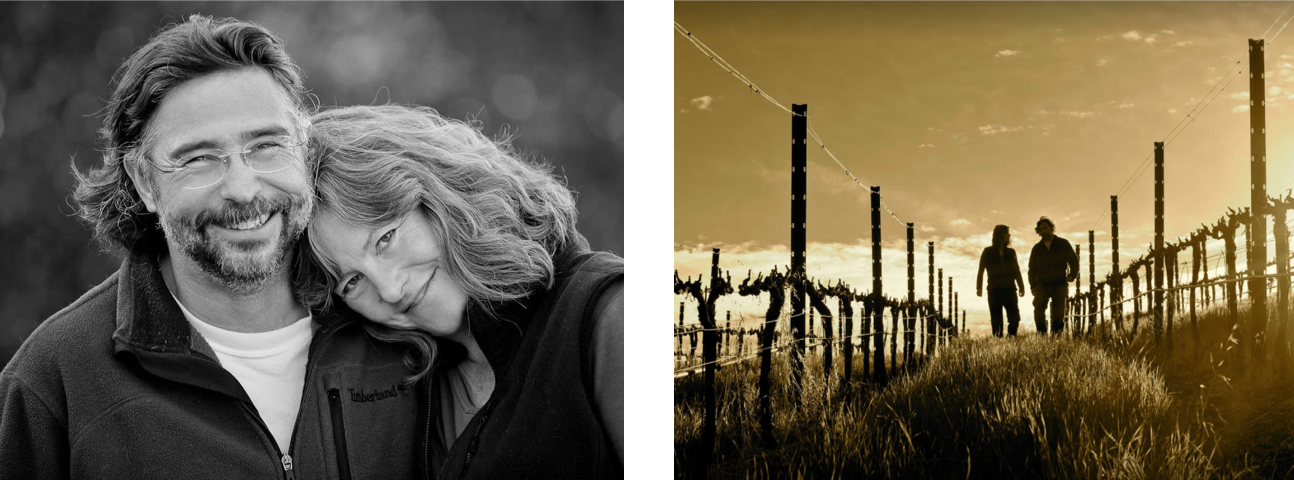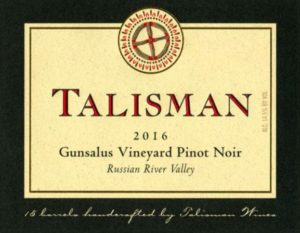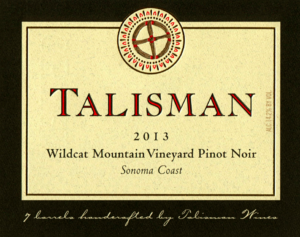
Pinot Noir – Weir Vineyard – Yorkville Highlands
| Country | USA |
|---|---|
| Region | California |
| Producer | Talisman |
| Size | 750mL |
| Style | Red |
| Practices | Sustainable |
| Grapes | Pinot Noir |
| Other Features | Woman-Owned/Crafted, Indigenous yeasts |
Planted in 1992, the Weir Vineyard is Talisman’s most far-flung vineyard. Located in the Yorkville Highlands between Cloverdale and Mendocino, the vineyard’s elevation (850’-1000’) and aspect place it squarely in the path of cold air flowing in from the Mendocino coast, a mere 17 miles away. The 15 acre vineyard incorporates several soil types, including gravels, highly fractured rock and old sandstone. The topsoil is thin, limiting vine growth and vigor, while promoting concentration in the resulting wines.
The grapes were picked on September 22nd. Afing in French oak barrels for 20 months. Pronounced black cherry on the nose, accented by fall baking spices, candied orange zest, brambly fruit, apple blossoms and white pepper. This elegant Pinot is bright and racy, yet velvety, lush and mouthcoatingly silky and sensual. Flavors of cranberry, strawberry, pink rose petals, Bing cherry, with an iron minerality and a hint of cedar grace the palate of this seamless, beautifully integrated, voluptuous and graceful wine. 14.6% alcohol. 309 cases produced.
About the Producer

Scott and Marta Rich launched Talisman in 1993, with just 204 cases of Madonna Vineyard Pinot Noir. They continued with only one Carneros bottling until 1999 when they expanded with a Russian River offering from Klopp Ranch - thanks to Merry Edwards, who offered them a share of that vineyard until her program grew. In 2001 their third wine came from Thorn Ridge, a fabulous site on the north edge of the Petaluma Gap on the Sonoma Coast. Soon thereafter Steve MacRostie approached them with the idea of a Talisman Pinot Noir from his very unique Wildcat Mountain site. Adastra vineyard joined the family with the 2005 vintage and Talisman was off to the races, adding a new vineyard every year or two to expand their offerings. In 2012 they finally crested 2000 cases. Their cuvées are typically 100-300 cases, though in recent vintages they've had a lot of fun crafting many tiny bottlings of specific vineyard blocks, clones or winemaking techniques. They continue to stay small and grow slowly, as they find vineyards of interest, with unique site characteristics and the potential to convey distinctive and singular terroirs. Talisman’s goal is very simple: the creation of exquisite Pinot Noirs that are true to their roots and accurately reflect their places of origin.
Scott Rich attended graduate school in the enology program at U.C. Davis and has worked as a research enologist for both RH Phillips and Robert Mondavi. He has been winemaker at Mont St. John, Carneros Creek, and Etude, where he made highly-acclaimed Pinot Noir and Cabernet. Currently, Scott's time and energy are spent as winemaker/owner of Talisman, as well as winemaker for Moraga Vineyards in Bel Air, California. Moraga produces sought-after Cabernet Sauvignon and Sauvignon Blanc.
Marta Rich actually has no memory of life without wine. Her father made wine in their Minnesota basement, using virtually any form of grapes or juice he could get. Yearning for warmer climes and more interesting terrain, Marta fled for the University of Colorado at Boulder, where she earned her degree in Psychology. After taking up residence in Napa Valley, Marta began an 18-year stint at Robert Mondavi. She worked her way up the ladder, first scheduling grapes during harvest and eventually running Mondavi's Northern California sales team. She was well-prepared for both of her current jobs, Director of Sales for Calera Wine Company, one of California's Pinot Noir pioneers, and Director of Sales & Marketing for Talisman Wines.
About the name: Scott's American Indian mother (an Arizona native) once gave him a special charm or talisman, that had been made and blessed by a medicine man. One of the elements of this talisman was the medicine wheel. This is now Talisman's logo. The elements of the medicine wheel represent the circle of life and the four directions, reminding us of our place in the universe. The rays around the wheel represent the sun, which provides energy for life on Earth and ripens grapes, allowing us to revel in the pleasure of life, including fine wine.
Sustainability: Talisman ditched capsules to be more eco-friendly. They buy their non-bleached, craft paper boxes from a solar-powered company. They are part of the 10% of small wineries that continue to use traditional glue labels. Most wineries have switched to pressure-sensitive (PS) labels which are basically stickers on a roll of backing. While PS labels are much easier to apply, there is a tremendous amount of waste associated with printing PS labels, and the backings most commonly used for PS labels are not recyclable and end up in the landfill. They just recycled an old labeling machine from Jaboulet and are now labelling in-house.
Talisman
The story of Talisman in the words of Scott Rich


